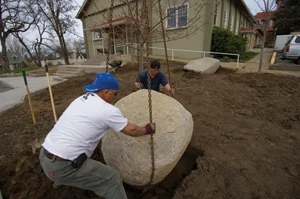By Larry Walton
Using Big Rocks to Give your Landscape a Solid New Look.
I’ve reached that stage in life where I’m asking the important questions like, “When is a boulder a boulder and not just a big rock?”
Rocks have always factored significantly in my life. Every year, the gravel road where I grew up had to be replenished because of the volume of rocks I used as ammo for my slingshot. Our diving platforms at our favorite swimming holes were large rocks. I even moved some big rocks with heavy equipment while building roads.
I’ve spent a lot of time removing rocks from our fields, garden spots and flower beds. But lately I’ve been putting some back. Some of my neighbors have also been putting some big rocks back in their landscapes, making good use of the naturally occurring resources in our area.
My favorite landscapes have been created over thousands of years where moss and ferns have taken root in dirt deposited by volcanoes, river erosion, earthquakes and composting trees. Sword ferns, vine maple and rhododendrons live in the shade of Douglas fir, hemlock and cedar trees. Leaving these environs intact and building around them is my first choice, but these opportunities are rare.
Taking a cue from nature, moving big rocks into our landscapes is a good option in many parts of the country. Sometimes the very rocks you’ll need are excavated from the ground in the process of leveling for foundations, digging for sidewalks and dozing for driveways. Such was the case with a new street in our neighborhood where hundreds of large rocks were unearthed to make room for utilities being installed beneath the street. Many of these rocks have found their way into our neighborhood’s yards.
While placing rocks in a landscape is not rocket surgery, there are some pitfalls and stumbling blocks to be avoided. Here’s how my neighbors are rocking their world:
















